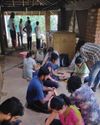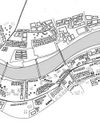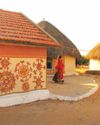In a city clawing for space, there are pockets that still retain a built fabric reminiscent of the olden days. In a city competing for modernity, there are precincts that hold onto a culture that is distinct and adds flavor to the otherwise bland every-day life. Aptly demonstrating this dichotomy, the restoration of the Cama Building at Murzban Colony in Mumbai by conservation architect Vikas Dilawari is a shining example of how conservation and restoration efforts not only preserve structures of the past, but also a way of life that is impossible to replicate outside of its cultural context.

Different entities approach problem-solving differently, but often the unanimously accepted approach is that of completely eliminating problem areas in order to implement the solution. Case in point is the current situation of choosing redevelopment over restoration and re-use. Of course, building from scratch has its own advantages. One can pre-empt issues that might crop up and design so as to mitigate them, aligned to the drastically different requirement of contemporary life. In comparison, restoration is tedious. One has to work within the set parameters of the existing structure, use rare crafts and materials, and adapt the often outdated program to keep pace with today’s times. And yet, what this kind of adaptive reuse does is something a new construction cannot – retain the old-world charm, the inherent culture of the site!
This is where conservation comes into the picture.
It is often said that ‘It is good not because it is old. It is old because it is good’ and nothing encapsulates heritage architecture better than this statement! Take for instance the Cama Building at Murzban Colony, Gilder Lane. Owned by the Garib Zarathostiona Rehthan Fund (GZRF), the colony was one of the first attempts at introducing the community housing concept in the late 19th century in and around central Mumbai, for the weaker sections of the community. Built in 1898, the colony has ever since nurtured a living tradition, a distinct culture and lifestyle for over a hundred years of its existence across generations of residents.
この記事は Indian Architect & Builder の October 2017 版に掲載されています。
7 日間の Magzter GOLD 無料トライアルを開始して、何千もの厳選されたプレミアム ストーリー、9,000 以上の雑誌や新聞にアクセスしてください。
すでに購読者です ? サインイン
この記事は Indian Architect & Builder の October 2017 版に掲載されています。
7 日間の Magzter GOLD 無料トライアルを開始して、何千もの厳選されたプレミアム ストーリー、9,000 以上の雑誌や新聞にアクセスしてください。
すでに購読者です? サインイン

Interlacing Perspectives
‘Meraki-2019’ A visionary Seminar series presented by Dr.Baliram Hiray College of Architecture, Bandra(East), Mumbai.

Facilitating A Community Through Architectural Practice
The humble, self-designed, self-built and organically planned home built by the majority of the world population rarely gets appreciated and critiqued as a viable lesson in architectural design.

The Art Of Solving Problems Creatively
The practice of architecture is perhaps incomplete without the complement of a variety of other arts.

Upcycling towards a playful tomorrow
Play is like the middle child, often forgotten, and always taking a back seat. For young kids, play can simply be running around, armwrestling with friends, building sandcastles on the beach, or singing popular music tracks in the shower.

Balancing The Poetics And Pragmatism Of Everyday Design
Humanity is faced with an oxymoronic crisis. The crisis involves the earth, the environment, impending looms of climate change, deforestation, loss of species, dwindling resources etc.

Just Give Me Some Space: Discussions And Beyond
Just Give Me Some Space (JGMSS) is Suha Riyaz Khopatkar’s debut book that paints a portrait of the dynamic life of an architecture student.

The Next In Vernacular Architecture
Architecture has become a capitalist.

Rethinking The Future: Architecture And Its Education
“I want to be like animals, the bird makes a nest in one or two days, the rat digs a hole in a night, but intelligent humans like us spend 30 years to have a house, that’s wrong.” - Jon Jandai

Uniting The Human-Scale With The City-Scale
London-based architect Usman Haque is famed for his interactive architectural systems, and for his exploration of newer, more effective ways of creating human engagement and interaction through his designs. Indian Architect & Builder caught up with him, to quiz him on a variety of topics such as his journey as an architect, his inspirations and philosophies, architects using the digital revolution to their advantage, and more!

Framing spaces
Almost every architect also doubles as a photographer or at least an enthusiast.